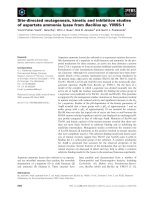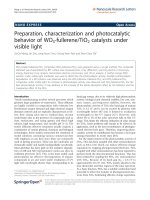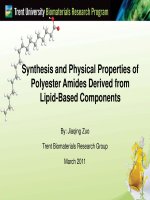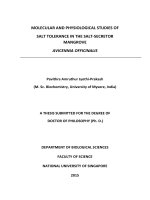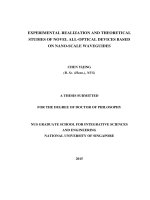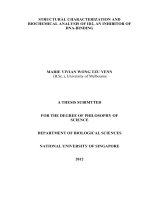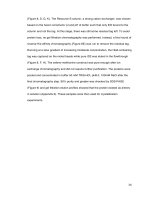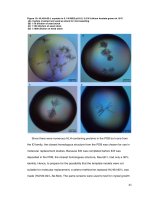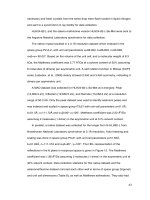Preparation, characterization and property studies of carbon nanostructures derived from carbon rich materials
Bạn đang xem bản rút gọn của tài liệu. Xem và tải ngay bản đầy đủ của tài liệu tại đây (9.91 MB, 210 trang )
PREPARATION, CHARACTERIZATION AND PROPERTY
STUDIES OF CARBON NANOSTRUCTURES DERIVED
FROM CARBON RICH MATERIALS
SAJINI VADUKUMPULLY
NATIONAL UNIVERSITY OF SINGAPORE
2011
Thesis Title: PREPARATION, CHARACTERIZATION AND
PROPERTY STUDIES OF CARBON NANOSTRUCTURES DERIVED
FROM CARBON RICH MATERIALS
Abstract
Carbon nanomaterials have always been an area of interest for their applications in all
the fields of science starting from materials science to biology. The current research is
focused on low cost and simple methodologies to prepare functional carbon
nanostructures from carbon rich precursors. Towards this goal, carbon nanofibers were
isolated from soot and employed as an adsorbent for the removal of amines from waste
water. Besides, various solution phase methods for the production of processable
graphene nanosheets directly from graphite were explored. This has been achieved by
both non-covalent stabilization and covalent functionalization of exfoliated graphene
sheets. Covalent functionalizations enable the incorporation of various functional
moieties onto graphene. The applicability of these functionalized graphene sheets in
polymer composites and metal hybrids were systematically investigated. Incorporation
of graphene improves the mechanical and thermal stability of the composites, along
with an increase in the electrical conductance.
Keywords: carbon nanofibers, graphene, covalent and non-covalent functionalization,
graphene/polymer composite, graphene/metal nanocomposites.
i
Acknowledgments
I am thankful to a lot of people who supported me throughout my PhD life and it is
a great pleasure to acknowledge them for their kind help and assistance.
First of all, I would like to thank my thesis advisor Dr. Suresh Valiyaveettil for
giving me an opportunity to work with him, for the constant support, guidance and
encouragement.
I would like to extend my sincere gratitude to all the current and past lab members
for their friendship and affection. I thank Ani, Gayathri, Nurmawati, Santosh, Bindhu,
Asha, Manoj, Rajeev, Sivamurugan, Satya, Balaji, Ankur, Pradipta, Tanay, Narahari,
Yiwei, Chunyan, Kiruba, Rama and Ashok for all the good time spent in lab and for
the useful discussions. I am thankful to Dr. Jegadesan for teaching me the basic
principles and operations of AFM. I would like to thank Jhinuk for her patience in
answering all my questions related to organic chemistry. I also appreciate the
assistances from Jinu Paul with the mechanical characterization and I-V
measurements. I take this opportunity to thank all my undergraduate and high school
students for their help in the work and it was a pleasure to work with them.
Special thanks to Prof. Sow Chong Haur and his lab members for helping with the
Raman and conductivity measurements. Technical assistance from Dr. Liu Binghai,
Ms. Tang and Mdm. Loy during SEM and TEM measurements is highly appreciated.
I would like to thank NUS-Nanoscience and Nanotechnology Initiative (NUSNNI)
for the graduate scholarship and department of Chemistry, NUS for the technical and
financial assistance.
Words cannot express my gratitude to my family members for their kind
understanding, moral support and encouragement. Without their support, this thesis
would not have been materialized.
ii
Table of Contents
Acknowledgments i
Table of Contents ii
Summary viii
Abbreviations and Symbols x
List of Tables xv
List of Figures xvi
List of Schemes xxiii
Chapter 1
Introduction – A Brief Review on Carbon Nanomaterials
1 Introduction
2
1.1 Carbon Nanomaterials
3
1.2 Graphene
5
1.2.1 Preparation of Graphene 6
1.2.1.1 Mechanical Exfoliation 7
1.2.1.2 Supported Growth 9
1.2.1.3 Wet Chemical Methods 13
1.2.1.3a Graphenes from GO 14
1.2.1.3b Unoxidized Graphene Sheets Directly from Graphite 15
1.2.1.3c Molecular Approach for the Production of Graphene 17
1.2.1.4 Unzipping of CNTs 18
iii
1.2.2 Characterization Techniques 19
1.2.3 Reactions of Graphene 21
1.2.3.1 Covalent Modifications 21
1.2.3.1a Hydrogenation 22
1.2.3.1b Covalent Modifications on GO 23
1.2.3.1c Covalent Modifications on Unoxidized Graphene Sheets 26
1.2.3.2 Non-covalent Modifications 30
1.2.3.3 Molecular Doping 34
1.2.4 Properties of Graphene 36
1.2.5 Graphene Based Hybrid Materials 38
1.2.6 Applications of Graphene 41
1.3 Aim and Scope of the Thesis
44
1.4 References
45
Chapter 2
Carbon Nanofibers Extracted from Soot as a Sorbent for the
Determination of Aromatic Amines from Wastewater Effluent
Samples
2.1 Introduction
70
2.2 Experimental Section
71
2.2.1 Reagents and Materials 71
2.2.2 Sample Preparation 72
2.2.3 Isolation of CNFs 72
2.2.4 Preparation of Electrospun CNF/PVA Composite
Nanofiber Mats
72
iv
2.2.5 Materials Characterization 73
2.2.6 µ-SPE using Electrospun CNF/PVA Composite
Nanofiber Mats
74
2.2.7 HPLC Analysis 74
2.3 Results and Discussion
74
2.3.1 Characterization of the CNFs 74
2.3.2 Analytical Evaluation of Electrospun CNF/PVA
Composite Nanofiber Mats as Adsorbent for µ-SPE
77
2.3.3 Control Study 78
2.3.4 Extraction Time 79
2.3.5 Desorption Solvent 80
2.3.6 Sample Volume 81
2.3.7 Desorption Time 82
2.3.8 Effect of Ionic Strength 83
2.3.9 Effect of pH 83
2.3.10 Method Validation 84
2.3.11 Application of Method for Real Sample Analysis 86
2.4 Conclusions
87
2.5 References
87
Chapter 3
Cationic Surfactant Mediated Exfoliation of Graphite into
Graphene Nanosheets and its Field Emission Properties
3.1 Introduction
94
3.2 Experimental Section
96
v
3.2.1
Materials and Methods 96
3.2.2 Preparation of Processable Graphene Nanosheets 96
3.2.3 Instrumentation 96
3.3 Results and Discussion
97
3.3.1 Control Studies 98
3.3.2 Exfoliation of Graphite in Presence of SDS 99
3.3.3 Exfoliation of Graphite in Presence of CTAB 99
3.3.4 Field Emission Properties of Graphene Nanosheets 105
3.4 Conclusions
108
3.5 References
108
Chapter 4
Flexible Conductive Graphene/Poly(vinyl chloride) Composite
Thin Films with High Mechanical Strength and Thermal
Stability
4.1 Introduction
113
4.2 Experimental Section
115
4.2.1 Materials 115
4.2.2 Preparation of Processable Graphene Nanosheets 115
4.2.3 Fabrication of Graphene/PVC Composite Thin Films 115
4.2.4 Instrumentation 116
4.2.5 Mechanical Characterization 116
4.2.6 Electrical Characterization 117
4.3 Results and Discussion
117
vi
4.3.1 Characterization of Graphene and Graphene/PVC Thin
Films
117
4.3.2 Mechanical Characterization of the Graphene/PVC Thin
Films
120
4.3.3 Dynamic Mechanical Thermal Analysis 122
4.3.4 Electrical Properties 127
4.4 Conclusions
128
4.5 References
129
Chapter 5
Functionalization of Surfactant Wrapped Graphene
Nanosheets with Alkylazides for Enhanced Dispersibility
5.1 Introduction
134
5.2 Experimental Section
136
5.2.1 Materials 136
5.2.2 Analysis and Instruments 136
5.2.3 Preparation of CTAB Stabilized Graphene Sheets 137
5.2.4 General Synthetic Procedure for Alkylazides 137
5.2.5 Synthesis of 11-azidoundecanol (AUO) 138
5.2.6 Synthesis of 11-azidoundecanoic acid (AUA) 138
5.2.7 Functionalization of CTAB Stabilized Graphene
Nanosheets with 11-azidoundecanoic acid (AUA)
139
5.2.8 Preparation of Gold/Graphene Nanocomposites 139
5.3 Results and Discussion
140
5.3.1 Characterization of the Functionalized Graphene
Nanosheets
140
vii
5.3.2 Characterization of Gold/Graphene Nanocomposites 146
5.4 Conclusions
149
5.5 References
150
Chapter 6
Bromination of Graphite - A Novel Route for the Exfoliation
and Functionalization of Graphene Sheets
6.1 Introduction
158
6.2 Experimental Section
159
6.2.1 Materials 159
6.2.2 Bromination of Graphite 160
6.2.3 Spreading of Brominated Graphite 160
6.2.4 Alkylation of Brominated Graphene 160
6.2.5 Suzuki Coupling Reaction with Brominated Graphene 161
6.2.6 Characterization 161
6.3 Results and Discussion
162
6.3.1 Brominated Graphite and its Stretching 162
6.3.2 Alkylation of the Brominated Graphite 165
6.3.3 Arylation of the Brominated Graphite by Suzuki
Coupling Reaction
170
6.4 Conclusions
173
6.5 References
173
Chapter 7
Conclusions and Future Prospectives
177
viii
Appendix
List of publications and presentations
182
183
ix
Summary
Nanostructures made of carbon have always been an area of interest for researchers
for their direct applications in all the fields of science starting from material science to
biology. Most of the reported procedures for the preparation of functional carbon
nanomaterials rely on expensive equipments and resources, high temperature and
pressure etc. Besides, most of the methods generate desired nanomaterials along with
significant amount of carbonaceous impurities such as amorphous carbon and catalyst
particles. Hence a post treatment is required before the material can be employed for
certain applications. The main interest of our current work was to pay attention to low
cost, simple, environmentally friendly methodology to generate functional carbon
nanostructures.
A brief summary of all types of carbon nanostructures, mainly graphene, its
methods of preparation, characterization techniques, properties, functionalization
techniques and applications have been explained in Chapter 1.
Chapter 2 deals with the isolation and characterization of carbon nanofibers
(CNFs) obtained from soot collected from burning of plant seed oil. The isolation is
accomplished by solvent extraction. The structure of CNFs is thoroughly investigated
using various spectroscopic and microscopic techniques. Moreover, the application of
CNFs in water purification is also investigated. CNFs are incorporated into a polymer
matrix via electrospinning and the resultant composite material is used as a µ-solid
phase extraction device for the extraction and preconcentration of aromatic amines
from water samples.
In Chapter 3 we investigated the possibility of solution based exfoliation of
graphite into graphene nanosheets without any oxidative or thermal treatments. The
combined effect of ultrasonication and non-covalent functionalization using
x
surfactants are employed for the exfoliation and dispersion of graphene nanosheets in
common organic solvents.
Chapter 4 describes the use of surfactant stabilized graphene nanosheets as
reinforcing filler in poly(vinyl chloride) (PVC) matrix at very low loading levels. The
composite thin films are prepared by solution phase blending in which PVC is
blended with different amounts of graphene nanosheets. Mechanical, thermal and
electrical properties of the composite films are investigated in detail.
In Chapter 5, the applicability of covalent functionalization on surfactant stabilized
graphene nanosheets are explored, where the dispersibility of the graphene nanosheets
are considerably enhanced. A series of nitrenes are employed for the covalent
functionalization and the role of functional groups on the nitrenes in stabilizing the
graphene dispersion is also investigated. Besides, the reactive sites on graphene
nanosheets are marked with metal nanoparticles. This approach provides a useful
platform for the fabrication of graphene/metal nanocomposites.
Chapter 6 demonstrates a simple and scalable surface treatment for the exfoliation
and subsequent functionalization of graphene sheets. Bromine atoms are covalently
attached to graphite, which can be easily substituted with alkylamines or boronic
acids, which help in enhancing the dispersibility and processability. This method
provides an easy and direct route towards the preparation of highly functionalized
graphene sheets.
xi
Abbreviations and Symbols
1D One dimensional
2D Two dimensional
3D Three dimensional
2L Bilayer
Å Angstrom
ABA
AES
4-aminobenzoic acid
Auger electron spectroscopy
AFM
ARPES
Atomic force microscopy
Angle resolved photoemission spectroscopy
AUA 11-azidoundecanoic acid
AUO 11-azidoundecanol
CDCl
3
Chloroform-d
C
6
F
6
Hexafluorobenzene
C
6
F
5
CF
3
Octafluorotoluene
C
6
F
5
CN Pentafluorobenzonitrile
C
5
F
5
N Pentafluoropyridine
CHCl
3
Chloroform
CNF Carbon nanofibers
CNT Carbon nanotubes
CTAB Cetyltrimethylammonium bromide
CVD Chemical vapour deposition
DCB Dichlorobenzene
DCC N, N-dicyclohexylcarbodiimide
xii
DCM Dichloromethane
DMA Dimethylamine
DMA Dynamic mechanical analyzer
DMF N,N-dimethyl formamide
DMSO
DNA
Dimethyl sulfoxide
Deoxyribonucleic acid
DNT Dinitrotoluene
DSC Differential scanning calorimetry
EDX
EELS
Energy dispersive X-ray analysis
Electron energy loss spectroscopy
EG Ethylene glycol
EG Expanded graphite
EI Electron impact
F4-TCNQ Tetrafluorotetracyanoquinodimethane
FESEM Field emission scanning electron microscopy
FET
FGS
Field effect transistor
Functionalized graphene sheets
FTIR Fourier transform infrared spectroscopy
gm Gram
GNR Graphene nanoribbons
GO Graphene oxide
h Hours
HBC Hexabenzocoronene
HCl Hydrochloric acid
HF Hydrogen fluoride
xiii
H
2
SO
4
Sulfuric acid
HOPG Highly ordered pyrolytic graphite
HPLC High pressure liquid chromatography
HSQ Hydrogensilsesquioxane
Hz Hertz
HTC Hydrothermal carbonization
ITO Indium tin oxide
KMnO
4
Potassium permanganate
KOH
LCD
LEED
Potassium hydroxide
Liquid crystal display
Low energy electron diffraction
LiAlH
4
Lithium aluminium hydride
LLE Liquid-liquid-extraction
LLLME Liquid-liquid-liquid micro-extraction
LOD Limit of detection
LOQ Limit of quantitation
m Multiplet
µg
Microgram(s)
µ-SPE
Micro-solid phase extraction
Me
4
Si Tetramethylsilane
mg Milligram(s)
ml Milliliter(s)
mmol
mV
Millimole(s)
Millivolt(s)
MWNT Multi-walled nanotubes
xiv
m/z Mass/charge ratio
NH
3
Ammonia
NLO Non-linear optics
NMP N-methylpyrrolidone
NMR Nuclear magnetic resonance
ODA Octadecylamine
ODCB 1,2-dichlorobenzene
PANI Polyaniline
PDDA poly(diallyldimethyl ammonium chloride)
PDI Perylenediimide
PEG Polyethylene glycol
PES Photoelectron spectroscopy
PFPA Perfluorophenylazide
Phe(N
3
) Azido-phenylalanine
PMMA Poly(methyl methacrylate)
PP Polypropylene
PPA Poly(phosphoric acid)
PPy Polypyrrole
PS
PSS
Polystyrene
Poly(sodium 4-styrenesulfonate)
PVA Poly(vinyl alcohol)
PVC Poly(vinyl chloride)
PyS Pyrene-1-sulfonic acid sodium salt
s Singlet
RSD Relative standard deviation
xv
SAED
SDBS
Selected area electron diffraction
Sodium dodecylbenzene sulphonate
SDS Sodiumdodecyl sulfate
SEM Scanning electron microscopy
SiC Silicon carbide
Si
3
N
4
Silicon nitride
SMA Styrene-maleic anhydride
SPANI
SPE
Sulfonated polyaniline
Solid-phase extraction
SPME Solid-phase microextraction
SPR Surface plasmon resonance
STM Scanning tunnelling microscopy
SWNT Single-walled nanotubes
t Triplet
TCB Trichlorobenzene
TEM Transmission electron microscopy
TGA Thermo gravimetric analysis
THF Tetrahydrofuran
TSG Turbostratic graphite
UV-vis Ultraviolet-visible spectroscopy
WPU Polyurethane
XPS X-ray photoelectron spectroscopy
XRD X-ray diffraction
δ
Chemical shift (in NMR spectroscopy)
xvi
Table No. List of Tables Page
No.
Chapter 1
Table 1.1
Summary of supported graphene growth on both metals
and carbide substrates.
11
Table 1.2
Comparison of different wet chemical approaches to
produce graphene suspensions.
13
Table 1.3
Comparison of different functionalization methods of
graphene.
35
Table 1.4
Major applications of graphene and graphene based
composite materials.
43
Chapter 2
Table 2.1
Quantitative data: linearity, precision (RSD), limit of
detection (S/N = 3), enhancement factors and linear
regression data obtained for anilines by the electrospun
CNF/PVA composite membrane microextraction
coupled with HPLC-UV.
85
Table 2.2
Concentrations of target aniline compounds (µg/l) in
waste water samples and the average recoveries
determined at 5 µg/l (*n.d-not detected. Relative
recovery values of spiked wastewater sample at 5 µg/l
compared to that of spiked pure water).
86
xvii
Figure No.
List of Figures Page
No.
Chapter 1
Figure 1.1
The structures of (A) diamond (B) graphite (C) fullerene
(C
60
) (D) CNTs and (E) graphene.
2
Figure 1.2
Schematic illustrations of the structures of (A) armchair
(B) zigzag (C) chiral SWNT and (D) TEM image of a
MWNT containing a concentrically nested array of nine
SWNTs.
3
Figure 1.3
Atomic structure of graphene.
5
Figure 1.4
Present techniques for making graphene.
7
Figure 1.5
Schematic of “Scotch tape” peeling off method to
produce graphene.
8
Figure 1.6
(A) Structure of HBC and (B) structure of the largest
graphene like molecule reported with 222 carbon atoms.
18
Figure 1.7
Chemical structure of a small edge-carboxylated
graphene nanoflake.
26
Figure 1.8
Schematic representation of the reaction between graphite
and ABA as a molecular wedge via Friedel Crafts
acylation in PPA/P
2
O
5
medium.
27
Figure 1.9
Schematic representation of alkylation of fluorinated
graphene sheets (blue: fluorine; yellow: -R group).
28
Figure 1.10
Nitrene addition to exfoliated graphite in refluxing
ODCB.
29
Figure 1.11
Fabrication of covalently immobilized graphene on
silicon wafer via the PFPA-silane coupling agent.
30
xviii
Figure 1.12
Schematic of self-assembly of Au NPs and PDDA-
functionalized graphene sheets.
33
Chapter 2
Figure 2.1
SEM images of the raw soot (A), extracted CNFs (B) and
TEM of CNFs (C) obtained from the soot by THF
extraction. Inset in C shows the SAED pattern obtained
from a single nanofiber.
75
Figure 2.2
Figure 2.3
XRD pattern obtained for the isolated CNFs.
FTIR (A) and the Raman spectra (B) of the CNFs.
75
76
Figure 2.4 HPLC chromatogram obtained for standard 1 mg/l. Peak
(1) 3-nitroaniline; (2) 4-chloroaniline; (3) 4-bromoaniline
and (4) 3,4-dichloroaniline.
77
Figure 2.5
Schematic of the extraction and desorption steps involved
in electrospun CNF/PVA composite membrane µ-solid
phase extraction.
77
Figure 2.6
Comparison of PVA and composite fiber mats (Extraction
conditions are as follows: 10 ml spiked 25 µg/l water
solution, no salt added and pH adjusted, extraction time
of 30 min, desorption time of 15 min in 100 µl of
acetonitrile).
78
Figure 2.7
Plot of HPLC peak area vs the extraction time (Extraction
conditions are as follows: 10 ml spiked 25 µg/l water
solution, no salt added and no pH adjustment, desorption
time of 15 min in 100 µl of acetonitrile).
79
Figure 2.8
Comparison of different desorption solvents (Extraction
conditions are as follows: 10 ml spiked 25 µg/l water
solution, no adjustment of salt and pH, extraction time of
40 min, desorption time of 15 min in 100 µl of
acetonitrile).
80
xix
Figure 2.9
Influence of sample volume on the extraction efficiency
(Extraction conditions are as follows: 10 ml spiked 25
µg/l
water solution no adjustment of salt content and pH,
extraction time of 40 min, desorption time of 15 min in
75 µl of acetonitrile).
81
Figure 2.10
Plot of HPLC peak area vs desorption time (Extraction
conditions are as follows: 30 ml spiked 25 µg/l water
solution no adjustment of salt content and pH, extraction
time of 40 min, desorption in 75 µl of acetonitrile).
82
Figure 2.11
Effect of salt addition on the extraction efficiency
(Extraction conditions are as follows: 30 ml spiked 25
µg/l water solution, no pH adjustment, extraction time of
40 min, desorption in 75 µl of acetonitrile).
83
Figure 2.12
Effect of sample pH on the extraction efficiency
(Extraction conditions as follows: 30 ml spiked water
solution (25 µg/l), no salt addition, extraction time of 40
min, desorption time of 15 min in 75 µl of acetonitrile).
84
Chapter 3
Figure 3.1
SEM image of the exfoliated product in acetic acid. 98
Figure 3.2
FESEM (A) and TEM (B) images of SDS stabilized
graphene sheets. Inset of figure 3.2B shows the HRTEM
image of one the edges of the multilayered graphite flake.
99
Figure 3.3
(A) UV-vis spectrum of the CTAB stabilized graphene
sheets dispersed in DMF. Inset shows a photograph of the
DMF solution. SEM of (B) HOPG and (C) the CTAB
stabilized exfoliated graphene.
100
Figure 3.4
(A) TEM image of surfactant stabilized graphene sheets.
(B) HRTEM image of a bilayer graphene sheet. (C) STM
image of a part of the monolayer graphene (inset
highlights the hexagonal lattice of the monolayer). (D)
Section analysis along the blue line which showing a
width of 1.148 nm for 4 hexagons and (E) along the green
102
xx
line which showing a width of 0.424 nm for 3 C-C bonds.
Figure 3.5
(A) Topographic view (10 × 10 µm) of the graphene
layers spin coated on mica. (B) AFM image of a single
graphene sheet (1 × 1 µm). (C) Height profile of the
image 3B. Statistical analysis of the AFM images of 60
nanosheets: (D) thickness, (E) length and (F) width of the
flakes.
103
Figure 3.6
(A) Raman spectra of HOPG and the CTAB stabilized
graphene nanosheets deposited on Si and (B) EDX
spectrum.
104
Figure 3.7
(A) Schematic representation of the experimental set up
for field emission measurement. (B) Graph showing the
field emission current density vs applied electric field. (C)
Fowler - Nordheim plot indicating the field emission
characteristics of exfoliated graphene nanosheets.
106
Chapter 4
Figure 4.1
(A) AFM image of the exfoliated graphene nanosheets,
(B) height profile of one of the sheets, (C) FESEM image
of graphene/PVC composite thin film with 2 wt%
concentration of graphene and (D) FESEM image of the
fractured end of the composite film after mechanical
testing.
118
Figure 4.2
XRD of graphene deposited on glass (trace a), 2 wt%
graphene/PVC composite film (trace b) and pure PVC
powder (trace c).
119
Figure 4.3
Raman spectra of pure graphene (trace a), 2 wt%
graphene/PVC composite film (trace b) and pure PVC
powder (trace c).
119
Figure 4.4
(A) Representative stress strain curves for various weight
fractions of the graphene/PVC composite films and (B)
the calculated Young’s modulus based on the slope of the
elastic region.
120
xxi
Figure 4.5
Mechanical properties of PVC thin films with different
graphene loadings when stretched at the rate of 0.01
N/min at 20 °C.
121
Figure 4.6
(A) Storage modulus and (B) Tan
δ
curves for the
graphene/PVC films when deformed at constant
amplitude of 0.1% at a frequency of 1 Hz at various
temperatures.
122
Figure 4.7
Graphs showing the temperature dependence of the
relative storage modulus at (A) low temperature regime
and (B) glass transition temperature regime.
124
Figure 4.8 Graph showing the glass transition temperature (T
g
) and
the loss factor (Tan
δ
) values at various weight fractions
of graphene in PVC matrix.
125
Figure 4.9
(A) TGA curves for graphene/PVC composite films and
(B) DSC curves to determine the glass transition
temperature.
126
Figure 4.10
Graph showing the influence of exfoliated graphene on
the electrical conductivity of PVC.
127
Chapter 5
Figure. 5.1
(A) AFM image of the CTAB stabilized graphene sheets
and (B) corresponding section analysis.
140
Figure 5.2
SEM images of (A) dodecylazide functionalized graphene
sheets and (B) hexylazide functionalized graphene sheets.
141
Figure 5.3
TEM images of (A) AUO functionalized graphene sheets
and (B) corresponding gold/graphene nanocomposite.
141
Figure 5.4
TEM images of AUA functionalized graphene sheets,
with 1:1 weight ratio of graphene vs AUA used. Inset
clearly shows the settled particles in the respective
dispersed solutions in toluene. All the sheets were found
to settle down within 1 h.
142
xxii
Figure 5.5
TEM images of (A) CTAB stabilized and (B) AUA
functionalized graphene sheets. (C) FTIR of AUA and
AUA functionalized graphene sheets (trace A and B,
respectively) and (D) Raman spectra of CTAB stabilized
(trace 1), AUA functionalized graphene sheets with 1:1
and 1:10 w/w of graphene to AUA.
143
Figure 5.6
AFM images of (A) the AUA functionalized graphene
sheets and (B) the section analysis.
145
Figure 5.7
Statistical analysis on the thickness of the AUA
functionalized graphene sheets.
145
Figure 5.8
STM images of (A) CTAB stabilized and (B) AUA
functionalized graphene sheets.
146
Figure 5.9
(A) UV-vis spectra of the AUA functionalized
graphene sheets (trace A) and that of the gold/graphene
nanocomposites (trace B) solutions. Inset of figure
5.9A shows the photograph of (A) functionalized
graphene solution and that of (B) the gold/AUA
graphene composite in DMF. (B) TEM image and (C)
the AFM image with (D) the cross-section analysis of
the gold/graphene nancomposite sheets.
147
Figure 5.10
I-V plots of films of (A) AUA functionalized graphene
sheets and (B) gold/graphene nanocomposites.
148
Chapter 6
Figure 6.1
FESEM (A) and AFM (B) image of the brominated
graphite drop-casted from toluene suspension.
162
Figure 6.2
FESEM (A) and TEM (B) image of the brominated
graphite sample deposited from water-toluene interface;
FESEM (C) and (D) TEM image of the 1:0.02 v/v
graphene/MWNT composite.
164
xxiii
Figure 6.3
(A) AFM image of the brominated graphite sample
deposited from water-toluene interface and (B) AFM
image of the 1:0.02 v/v graphene/MWNT composite.
164
Figure 6.4
(A) Raman spectra of (a) pure graphite (b) brominated
graphite (c) alkylated graphene and (d) debrominated
graphene sheets after alkylation and (B) FTIR spectra of
(a) brominated graphite (b) alkylated and (c)
debrominated sheets after alkylation.
166
Figure 6.5
Weight loss of (a) brominated graphite and (b)
dodecylated graphite determined by TGA analyses in
nitrogen.
167
Figure 6.6
(A) FESEM and (B) AFM images of the dodecylated
graphene sample (without sonication).
168
Figure 6.7
(A) AFM image of the dodecylated graphene sheets after
dispersion, (B) corresponding section analysis; and (C)
TEM image.
169
Figure 6.8
I-V plots of drop casted films of (a) brominated graphite
(b) dodecylated graphene and (c) debrominated product
after dodecylation.
170
Figure 6.9
Absorption (A) and emission (B) spectra for (a) Ph-BTP
(b) G-BTP excited at 410 nm; Absorption (C) and
emission (D) spectra for (a) Ph-Py (b) G-Py excited at
340 nm.
171
Figure 6.10
Raman spectra of (A) G-BTP (a - brominated graphite; b
- G-BTP; c - debrominated G-BTP) and (B) G- Py (a -
brominated graphite; b - G-Py; c - debrominated G-Py).
172
Figure 6.11
(A) TEM and (B) AFM image of bithiophene coupled
graphene; (C) TEM and (D) AFM image of pyrene
coupled graphene.
172
